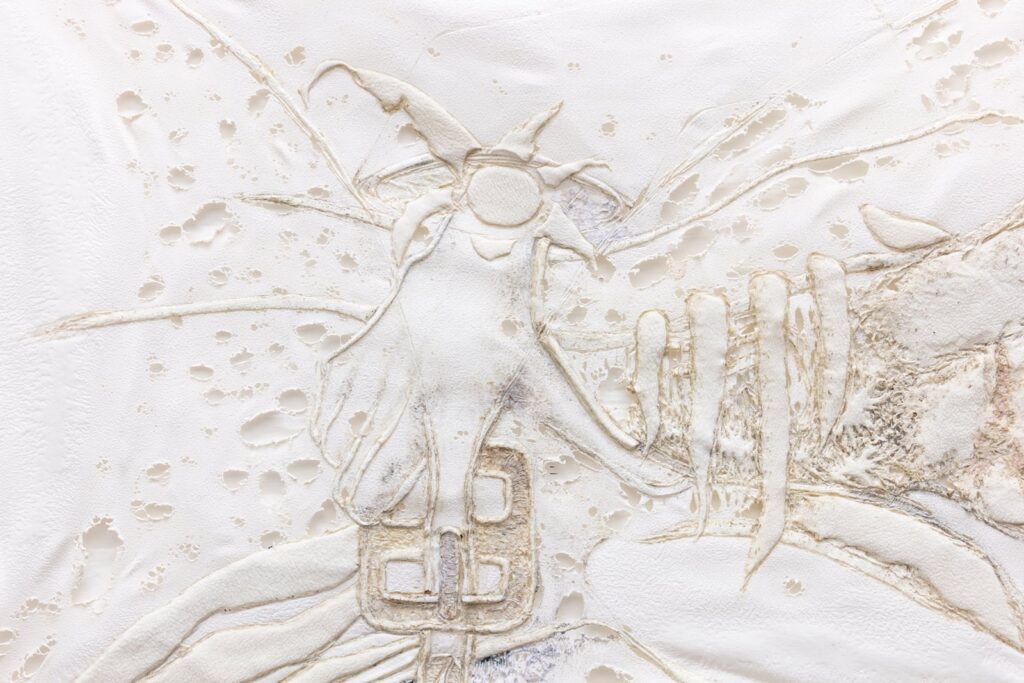Artist: Judita Levitnerová
Title: Head to Presser
Venue: Galerie mladých, Brno
Curator: Ivana Hrončeková



Judita Levitnerová takes interest in textiles in a wide range of meanings. Through a handmade paraphrase of industrial automated production, she explores the phenomenon of gendered labor, the influence of hard manual labor on identity formation and the tradition of artistic crafts and leisure handicrafts.

The title Head to Presser is a wordplay that replaces a part of the human body with a mechanical component of a sewing machine. It refers to the thesis of sociologist Richard Sennet, who criticizes the different perceptions of the prestige of working with the head and working with hands. He considers this social boundary to be fabricated and, in the spirit of the slogan “Making is Thinking”, blurs the distinction between craft and art. To better illustrate, he uses the analogy of the craftsman with his manual dexterity to the feel of the violinist’s hand. Prolonged and repetitive hand movements are inevitable for both professions, as are the demands for a certain creativity or ability to solve a specific problem inventively that are typically associated with intellectual work. The question remains how the groups being compared would be able to identify with this analogy and, if not, what deeper reasons would lead them to do so. In the Czech context, possible answers can be found in sociologist Kateřina Nedbálková’s research on the environment of the Baťa factory, however far removed the factory’s Fordist production regime is from the concept of autonomy and creativity of craft activity.
However, differences in the prestige of individual jobs can also be observed within the factory. The hierarchies are graded from the artisanal professional tasks to the mechanical ones that can be performed by “anyone on the street”. At the top rank then stands the craftsmanship, apprenticeship in a trade combined with heavier manual tasks that require strength and experience, i.e., the so-called “handling of work by hand”. This (in the context of the factory) financially and symbolically above-average work is mainly performed by men, despite their disproportionately smaller representation. In addition to gender differences in wages, this also implies that apprenticeship, i.e., professional training in a trade, is a mark of distinction even in the apparently homogeneous factory workforce.



At the borderline between craft and mass production, there were also a number of other factories producing textile products during the socialist industrial period. In the context of Judita Levitnerová’s work, it is interesting to recall, for example, the art protis technique, which enabled the production of non-woven tapestries. Art protis is created by layering layers of worsted and dyed fleece on top of each other, finally, the whole surface is weighted, ironed together and stitched through a series of stitches. The technique allowed the creation of small series of textile paintings. Judita Levitnerová replicates this mechanical serial process of weaving, fusing and stitching systematically with handmade artwork. This inadvertently alludes to the context of female labor and opens up the topic of the position of women in neoliberal capitalism. However, she treats the material subversively. She “embroiders” textile images from second-hand clothing fabrics using the technique of pyrography. Through this DIY technique, she materializes Sennet’s thesis and blurs the boundaries of “serious” art, “hobbyism”, craft and mass production. At the same time, it alerts us to the need for a fundamental revision of the approach to work, especially in its social class connotations. It problematizes the established separation of less valuable and more valuable work or less necessary and more necessary work. In doing so, it also touches on the position of artistic work itself, in which the traditional boundaries of intellectual and manual activity merge, and which in the wider consciousness teeters on the borderline between prestige and uselessness, elitism and marginality. However, the installation at Galerie mladých looks around and asks questions rather than manifesting anything.





